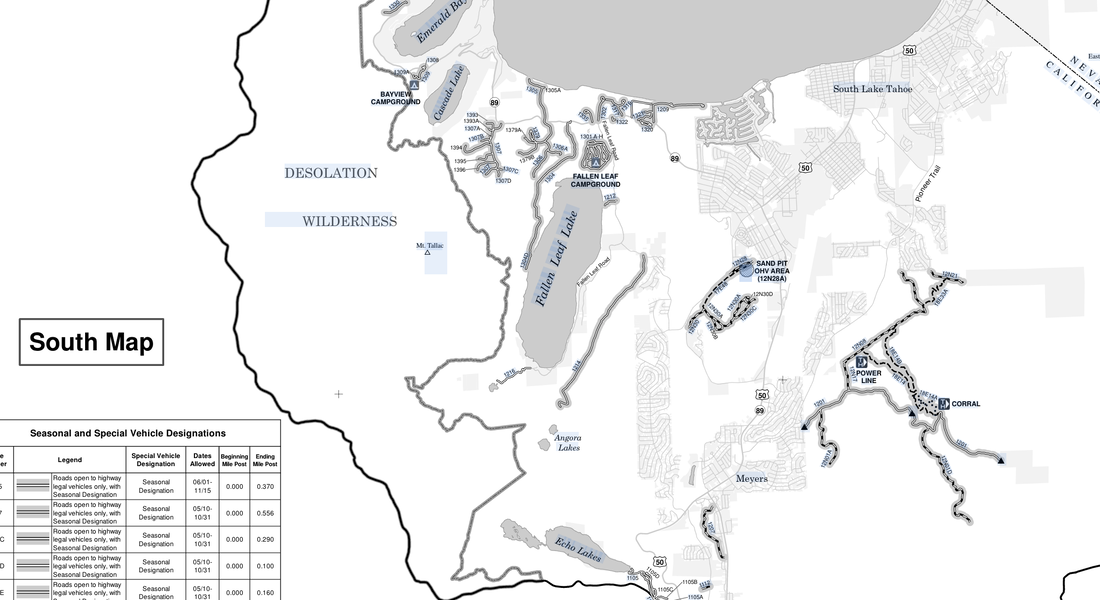Access the new map HERE.
SOUTH LAKE TAHOE, Calif. – As snow is melting off the trails and the days are getting warmer, for the most part, many recreationists are ready to get outside on foot and on bikes. One of those ways to enjoy the outside at Lake Tahoe that is gaining in popularity is on an electric bicycle, also known as an e-bike. Where one can take an e-bike is often confusing.
E-bikes are seen on both motorized and non-motorized trails around Lake Tahoe, and the US Forest Service is creating the rules for the lands they manage.
Currently, e-bikes are only allowed on Forest Service trails in the Lake Tahoe Basin that allows motorized vehicles except for a few exceptions. They are not allowed on the Tahoe Rim Trail (TRT) with the exception of the TRT in Lake Tahoe Nevada State Parks. Although some California State Parks do allow class 1 and class 2 e-bikes on trails, e-bikes are not allowed on the Ocelot Trail near Tahoe City, according to the Tahoe Area Mountain Bike Association (TAMBA).
The USDA Forest Service Lake Tahoe Basin Management Unit (LTBMU) is developing a plan to improve e-bike access and trail system sustainability on National Forest System lands in the Lake Tahoe Basin. The Forest Service's office in Washington, D.C. said this week its internal guidance on how future e-bike use is managed on national forests and grasslands has been finalized. The updated guidance clarifies existing policy and provides guidelines to LTBMU.
According to the LTBMU Planning Staff Officer Ashley Sibr, this information from Washington directs them to identify minimum road system needs for safe and efficient travel and for administration, utilization, and protection of NFS lands under the travel management rule (https://www.fs.usda.gov/science-technology/travel-management), which is what is currently underway with the LTBMU’s Basin-Wide Trails Project.
The Basin-Wide project would alter the trail system map to allow Class 1 e-bikes on specific trails and clarify trails where motorized access is permitted. It would also upgrade road/trail crossings over streams and wet areas, and upgrade trailhead parking areas.
Class 1 e-bikes are low-speed pedal-assisted electric bicycles, that are equipped with a motor that provides assistance only when the rider is pedaling and that stops providing assistance when the bicycle reaches 20 mph.
Class 2 e-bikes are low-speed throttle-assisted electric bicycles that are equipped with motors that can exclusively propel the bicycle, but that cannot provide assistance when the bike reaches 20 mph.
Around Lake Tahoe, LTBMU currently allows all e-bikes on all Forest Service roads that are already open to motorized vehicles. The new finalized guidance allows e-bikes to continue to operate on currently-authorized roads and trails and laid out a process to evaluate future requests for expanded access.
In February 2021, the LTBMU released a Proposed Action for the Basin-Wide Trails Project, which included a public comment period. Currently, the LTBMU is analyzing which trails are appropriate for e-bike use and after the decision is made, we will have a new motor vehicle use map with new designations for trails that allow e-bike use.
Proposed actions for the project:
- Change 87 miles from non-motorized trails to motorized trails open to class 1 e-bikes only
- Change 1 mile from motorized use to motorized trails open to class 1 e-bikes only (this action is associated with reroute of motorized use from E12 to E7/E5)
- Designate 4 miles of existing non-motorized trails as motorized, trails open to motorcycles only, seasonal
- Decommission approximately 3 miles of existing trails (These actions are associated with proposed trail reroutes)
- Construct 23 miles of multi-use trails that are designated as motorized trails open to class 1 e-bikes only (6 of these total miles are associated with trail reroutes)
- Construct 1 mile of trail designated as non-motorized
- Construct 5 miles of new trails designated as motorized trails open to motorcycles only, seasonal
- Construct 3 new trailhead facilities•Comply with USDA Forest Service, Tahoe Regional Planning Authority, and Lahontan Water Board Best Management Practices (BMPs) and Resource Protection Measures (RPMs) for trail and road maintenance, construction, and decommissioning activities.
The final plan is expected to be approved and released by the end of summer, 2022.
Trails and dates open to e-bikes in the Lake Tahoe Basin - Motor Vehicle Use Maps (MVUM):
18E14 Corral Trail – Open dates in the MVUM are 05/25 to 11/15
18E14B Incense Cedar - Open dates in the MVUM are 05/25 to 11/15
18E14A Sidewinder - Open dates in the MVUM are 05/25 to 11/15
18E33A High Meadow OHV - name is Power Line Connector, Open dates in the MVUM are 05/25 to 11/15
18E40 Stinger – Open date in the MVUM 05/01
18E18, 18E18B, 18E18C, 18E18D, 18E18E, 18E18F Beaver Tail Network - Open dates in the MVUM May 25 – Nov 14, accessed by Beaver Street open May 25 – Nov 14
Flume Trail – National Forest lands are not open to motorized travel (e-bikes are designated motorized) however, NV State Parks does allow eBikes on their land.
Tahoe Rim Trail (Hobart Rd to Tunnel Creek Rd only) National Forest lands are not open to motorized travel (e-bikes are designated motorized) however, NV State Parks does allow eBikes on their land.
All fire roads that allow motorized vehicles – only if shown in the MVUM
12N28 and 12N28A Sand Pit Access and the Sand Pit- Open dates in the MVUM are 05/10 to 11/15
For the MVUM map, visit https://usfs-public.app.box.com/v/ltbmu-mvum-south
CLICK HERE to view the original article and photos in SouthTahoeNow.com

 RSS Feed
RSS Feed